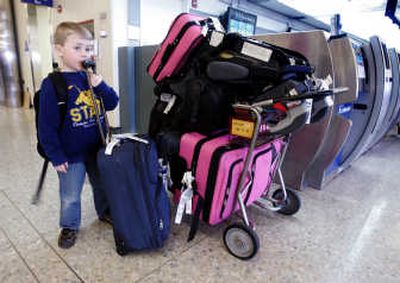Small air carriers’ failures are no threat to majors, yet

A slowing economy and high fuel prices appear to have killed off tiny ATA Airlines, Aloha Airlines, and Champion Air. A big pile of cash will keep the big airlines from that same fate, for now.
It’s not that the big carriers aren’t buffeted by the same forces that shut down ATA on Thursday – leaving frustrated travelers scattered around the country – and Aloha on Tuesday. Champion Air, a Minnesota-based charter airline, will stop flying by May 31.
ATA had more than 2,200 employees, and “virtually all” were told that their jobs were gone, company spokesman Michael Freitag said. Once the nation’s 10th-largest air carrier, ATA entered bankruptcy for the second time in just over three years Wednesday.
But the nation’s biggest airlines have hoarded some $19 billion in cash as of the end of 2007, according to a tally by Calyon Securities analyst Ray Neidl. Even if fuel stays at today’s levels and revenue drops 2 percent, they would still have $14.7 billion in cash at the end of 2009, under Neidl’s estimate.
That’s less cash than the 10 percent of revenue they like to keep, but enough to hold off a crisis, analysts say. The only carrier in Neidl’s analysis with less than 5 percent of revenue in cash at the end of 2009 would be Frontier Airlines, which would have just $4 million by then.
He believes the older hub-and-spoke airlines “and most of the low-cost carriers will survive the weak economic environment and high fuel prices over the next two years, though with not much room to spare,” he wrote in a note on Saturday.
“They are fairly well-situated, but it’s important to remember that a lot of their cash needs have changed now,” said Moody’s Investors Service analyst George Godlin. “Their fuel costs have gone up dramatically. And the cost of putting in place fuel hedging contracts has also gone up exponentially.”
Size-wise, the major carriers are in an entirely different league than the small airlines that failed this week. The largest one, ATA, employs one-sixteenth as many people as US Airways Group. So the smaller airlines failed after losing key customers (ATA and Champion) or because of intense price competition in a single market (Aloha). The larger carriers are big enough to ride out that kind of turbulence.
Not that they aren’t nervous. On Thursday Northwest said it would stop hiring new pilots and fly 5 percent less than planned this fall because of high fuel prices. The carrier pointed out that its $3 billion in cash works out to 24 percent of its 2007 revenue. “We are pro-actively making those decisions now to maximize our liquidity position,” President and chief executive Doug Steenland said in a written statement.
Northwest also said it would remove an additional 15 to 20 planes from service this year, including about 10 DC-9s. Those aging aircraft are financially easier cheaper to park because they’re paid for.
Aviation consultant Michael Boyd said larger airlines such as Northwest and United can weather high fuel prices better because more of their fleet is already paid for.
“From that perspective, what happened with ATA is not a harbinger of things to come in the rest of the industry,” he said. “Most big carriers have parts of their fleet they can park very cheaply.”
Airline consultant Robert Mann said the collapse of ATA shows it’s becoming harder than ever for carriers to secure adequate financing, even from nontraditional sources such as hedge funds.
“You really see that the airlines have the cash on their balance sheets, and that’s it,” he said. “When they’re out of that, there may be no replacing it.”